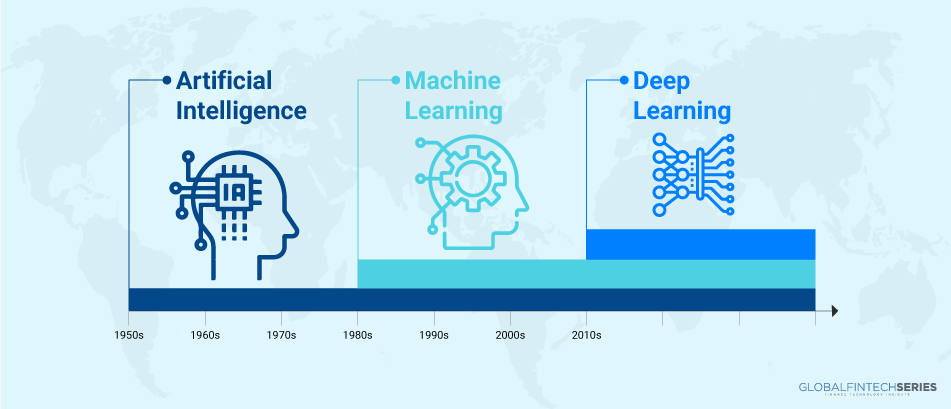The terms Artificial Intelligence, Machine Learning, Deep Learning, and Data Science are prevalent in the current era. Additionally, it is more essential to comprehend what it is and the distinction between them. Despite the fact that these terms may be closely related, there are differences among them. Application and impact of Artificial Intelligence (AI), Machine Learning (ML), and Deep Learning (DL) technologies in the financial services sector are on the rise. According to studies on digital transformation, insurers view the implementation of AI technology as the most promising avenue for business growth. Similarly to distributed ledger technology, the deployment of AI and its applications (ML and DL) is maturing at a faster rate in the banking sector. Utilizing such technologies and models in financial services can be advantageous for households, businesses, and the economy. However, regulators are concerned that AI characteristics such as computational power and speed, model complexity, and data challenges have the potential to cause consumer harm, damage market integrity, impact the safety and soundness of individual firms, and undermine the financial stability of the economy as a whole.
What Is Artificial Intelligence?
Definitions of AI vary. IOSCO defines AI “as the study of methods for making computers mimic human decisions to solve problems. It incorporates tasks like learning, reasoning, planning, perception, language understanding, and robotics.” The Bank of England’s and FCA’s AI Public-Private Forum (AIPPF) characterizes artificial intelligence comprehensively as the utilization of cutting-edge measurable procedures with enormous computational and information needs. People have for some time been fixated on raising simulated intelligence since the issue, “Can machines think?”, was presented by Alan Turing in 1950. Computer-based intelligence empowers the machine to think, that is with no human intercession the machine will actually want to take its own choice.
A vast area of software engineering makes machines appear to have human intelligence. Programming a computer to drive a vehicle by obeying traffic lights is not sufficient; the programme must also be able to exhibit human-like behaviour. As a result of innovations made in recent years, producers are close to offering such solutions. In fact, they are investigating AI applications in virtually every significant industry, from the industrial to the public sector. With improved algorithms and larger data stores, the error rate of computer calculations for image recognition and several other cognitive functions is now frequently comparable to or better than that of humans. In addition, equipment performance has vastly improved, enabling machines to manage this unprecedented volume of data. This has been a significant factor in the improvement of artificial intelligence model precision.
Recommended: Would Mobile Applications Drive the Next-Level of Business Growth in Insurance Industry?
What Does Machine Learning Entail?
Machine Learning is a subset of Artificial Intelligence that employs statistical learning algorithms to build frameworks that can consequently learn and improve without being modified based on experiences. ML is defined by IOSCO as a subset and application of AI. The majority of us use AI in our daily lives, such as Netflix, YouTube, and Spotify; web crawlers such as Google and Yahoo; and voice assistants such as Google Home and Amazon Alexa. In AI, we train the calculation by providing it with a large amount of data and allowing it to examine the processed data. These machine learning algorithms are classified as supervised, unsupervised, and reinforcement learning, and they have countless applications, including Image Recognition, Voice Recognition, Predictions, Video Surveillance, Social Media Platform, Spam and Malware, Customer Support, Search engines,, Applications, Fraud, and Preferences, etc.
Read: Global Fintech Interview with Jitin Bhasin, Founder & CEO at SaveIN
Machine Learning Applications:
- Image Recognition to send related notifications to individuals.
- Voice Recognition- VPA
- Predictions regarding the price of cable for a specific duration and traffic congestion.
- Videos A surveillance system designed to detect crimes before they occur.
- Using the user’s interests as a guide, news and advertisements on Social Media platforms are improved.
- Spam and Malware benefit from Rule-based, multi-layer, and tree induction techniques.
- Customer Support responses are provided by a chatbot.
- Search Engine that provides the most relevant results to users.
- Companies and applications such as Netflix, Facebook, Google Maps, Gmail, and Google Search.
What exactly is Deep Learning?
Deep Learning is essentially a simulation of the human brain, and it can also be described as a multi-brain network engineering with a vast number of parameters and layers. Deep learning is an AI technique inspired by the way the human mind processes information; it essentially learns from examples. It assists a computer in displaying information through layers to anticipate and organise data. Since deep learning processes information in a manner similar to that of the human brain, it is typically applied to tasks that are typically performed by humans. The essential technology behind driverless vehicles enables them to recognise a stop sign, a person on foot, and a lamppost. Most neural network architectures employ brain network models, so they are often referred to as deep neural networks.
Applications of Deep Learning
First of all, deep learning and machine learning are part of the same artificial intelligence (AI) family. Unlike ML’s assignment and explicit algorithms, deep learning utilises learning information portrayals. Moreover, the knowledge model created by deep learning can be administered, semi-regulated, or even unsupervised. Deep learning innovations like deep neural networks and deep belief networks are a piece of numerous business cases that incorporate speech recognition, natural language processing, filtering website content, or anything where you really want to repeat human learning that you can stack up an information base to reenact the information on a large number of specialists.
So, what makes it so “deep”? The term “deep” in deep learning refers to the number of data transformation layers. Or, the depth of the credit assignment path (CAP).
Deep learning has recently become available in public clouds as an additional artificial intelligence decision, either coupled with or decoupled from ML, which is currently in widespread use. Simulated intelligence is not new, nor are its offspring AI and deep learning. What is new is the drastically reduced cost of these AI technologies, which previously exceeded the budgets of the vast majority of business applications. The cloud changed all of it. However, the risk associated with deep learning is that it is frequently applied to inappropriate use cases. Cloud-based or on-premises applications that function optimally with conventional or procedural administrators are the most suitable. Currently, these frameworks can access the vast amount of data that must be connected to Deep learning frameworks without requiring the overhead and latency of full-fledged deep learning systems.
The ability to recognise patterns and interpret their meaning. This would include vocal patterns, visual patterns, etc. It is an automated process of self-improvement for the project to bring these patterns to the attention of the application and to learn from the experience of finding the right patterns.
The capacity to identify and interpret anomalies. Similarly, when repeating patterns, we can look for instances and instances that deviate from the overall pattern. An example would be the discovery of a defect in the bumper of a new vehicle on the production line floor, resulting in a notice to the floor director that it should be fixed or removed.
Clearly, this is not an exact science. Deep learning frameworks provide a variety of features that can be used to develop business applications. The underlying assumption is that we are not restricted to conventional procedural logic. Now we can expedite the development of frameworks that improve as they operate. You should consider cloud-based deep learning systems given their reasonable pricing.
Recommended:Fintech Web Ads Should Comply with Federal Consumer Finance Protections
[To share your insights with us, please write to sghosh@martechseries.com]

